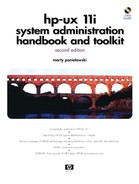crontab
crontab -
 Schedule jobs that are executed automatically on a regular basis.
Schedule jobs that are executed automatically on a regular basis.
crontab(1) crontab(1)
NAME
crontab - user job file scheduler
SYNOPSIS
crontab [file]
crontab -e
crontab -l
crontab -r
DESCRIPTION
The crontab command manages a crontab file for the user. You can use
a crontab file to schedule jobs that are executed automatically by
cron (see cron(1M)) on a regular basis. The command has four forms:
crontab [file] Create or replace your crontab file by copying
the specified file, or standard input if file
is omitted or - is specified as file , into the
crontab directory, /var/spool/cron/crontabs.
The name of your crontab file in the crontab
directory is the same as your effective user
name.
crontab -e Edit a copy of your crontab file, or create an
empty file to edit if the crontab file does not
exist. When editing is complete, the file will
be copied into the crontab directory as your
crontab file.
crontab -l List your crontab file.
crontab -r Remove your crontab file from the crontab
directory.
The entries in a crontab file are lines of six fields each. The
fields are separated by spaces or tabs. The lines have the following
format:
minute hour monthday month weekday command
The first five are integer patterns that specify when the sixth field,
command, should be executed. They can have the following ranges of
values:
minute The minute of the hour, 0-59
hour The hour of the day, 0-23
monthday The day of the month, 1-31
month The month of the year, 1-12
weekday The day of the week, 0-6, 0=Sunday
Each pattern can be either an asterisk (*), meaning all legal values,
or a list of elements separated by commas. An element is either a
number in the ranges shown above, or two numbers in the range
separated by a hyphen (meaning an inclusive range). Note that the
specification of days can be made in two fields: monthday and weekday.
If both are specified in an entry, they are cumulative. For example,
0 0 1,15 * 1 command
runs command at midnight on the first and fifteenth of each month, as
well as every Monday. To specify days in only one field, set the
other field to asterisk (*). For example,
0 0 * * 1 command
runs command only on Mondays.
The sixth field, command (the balance of a line including blanks in a
crontab file), is a string that is executed by the shell at the
specified times. A percent character (%) in this field (unless
escaped by a backslash ()) is translated to a newline character,
dividing the field into "lines". Only the first "line" (up to a % or
end-of-line) of the command field is executed by the shell. Any other
"lines" are made available to the command as standard input.
Blank lines and those whose first non-blank character is # will be
ignored.
cron invokes the command from the user's HOME directory with the POSIX
shell, (/usr/bin/sh). It runs in the c queue (see queuedefs(4)).
cron supplies a default environment for every shell, defining:
HOME=user's-home-directory
LOGNAME=user's-login-id
PATH=/usr/bin:/usr/sbin:.
SHELL=/usr/bin/sh
Users who desire to have their .profile executed must explicitly do so
in the crontab entry or in a script called by the entry.
You can execute crontab if your name appears in the file
/var/adm/cron/cron.allow. If that file does not exist, you can use
crontab if your name does not appear in the file
/var/adm/cron/cron.deny. If only cron.deny exists and is empty, all
users can use crontab. If neither file exists, only the root user can
use crontab. The allow/deny files consist of one user name per line.
EXTERNAL INFLUENCES
Environment Variables
LC_CTYPE determines the interpretation of text within file as single-
and/or multi-byte characters.
LC_MESSAGES determines the language in which messages are displayed.
If LC_CTYPE or LC_MESSAGES is not specified in the environment or is
set to the empty string, the value of LANG is used as a default for
each unspecified or empty variable. If LANG is not specified or is
set to the empty string, a default of "C" (see lang(5)) is used
instead of LANG.
If any internationalization variable contains an invalid setting,
crontab behaves as if all internationalization variables are set to
"C". See environ(5). EDITOR determines the editor to be invoked when
-e option is specified. The default editor is vi.
International Code Set Support
Single-byte and multi-byte character code sets are supported.
WARNINGS
Be sure to redirect the standard output and standard error from
commands. If this is not done, any generated standard output or
standard error is mailed to the user.
FILES
/var/adm/cron Main cron directory
/var/adm/cron/cron.allow List of allowed users
/var/adm/cron/cron.deny List of denied users
/var/adm/cron/log Accounting information
/var/spool/cron/crontabs Directory containing the crontab files
SEE ALSO
sh(1), cron(1M), queuedefs(4).
STANDARDS CONFORMANCE
crontab: SVID2, SVID3, XPG2, XPG3, XPG4
..................Content has been hidden....................
You can't read the all page of ebook, please click here login for view all page.
